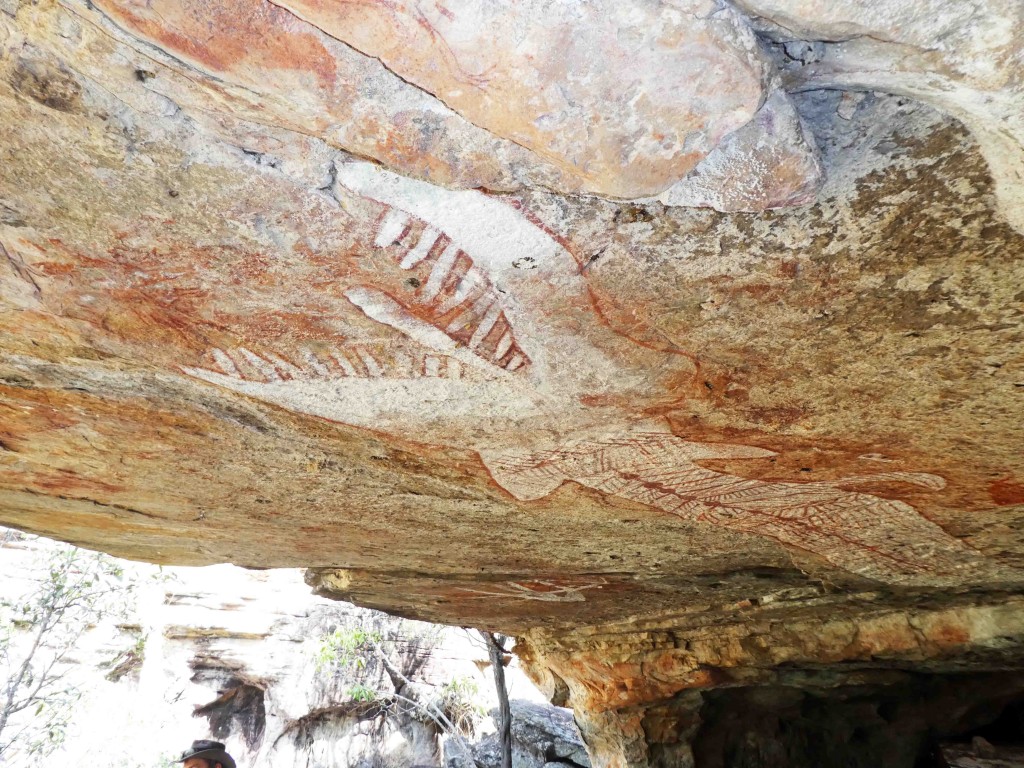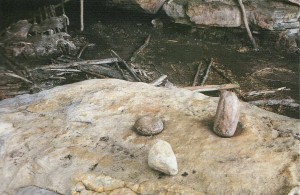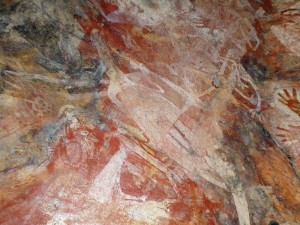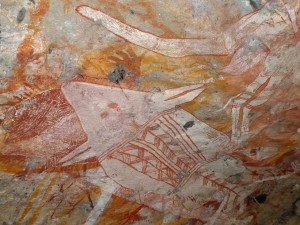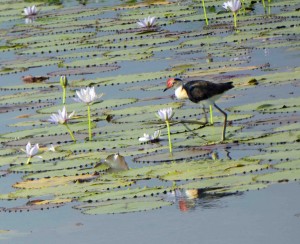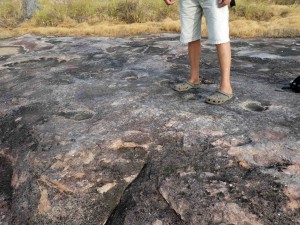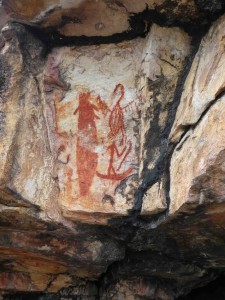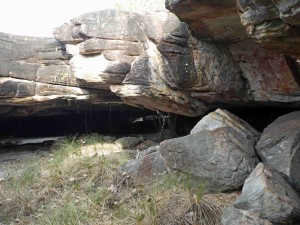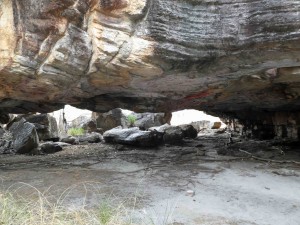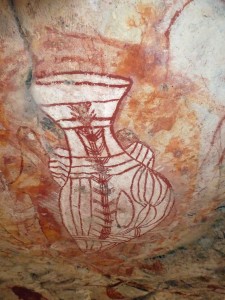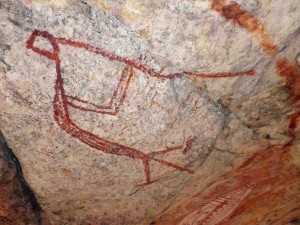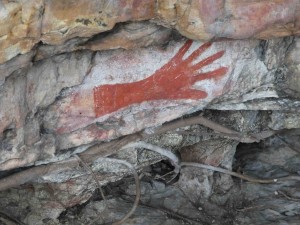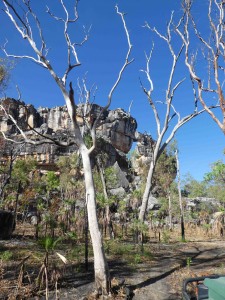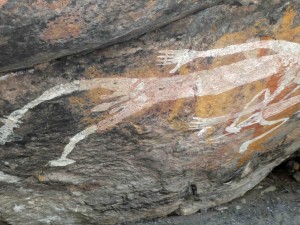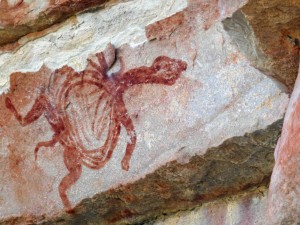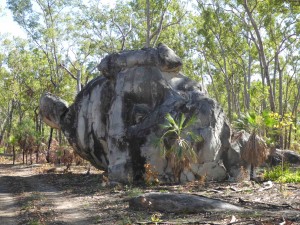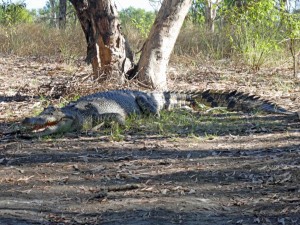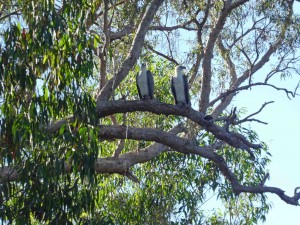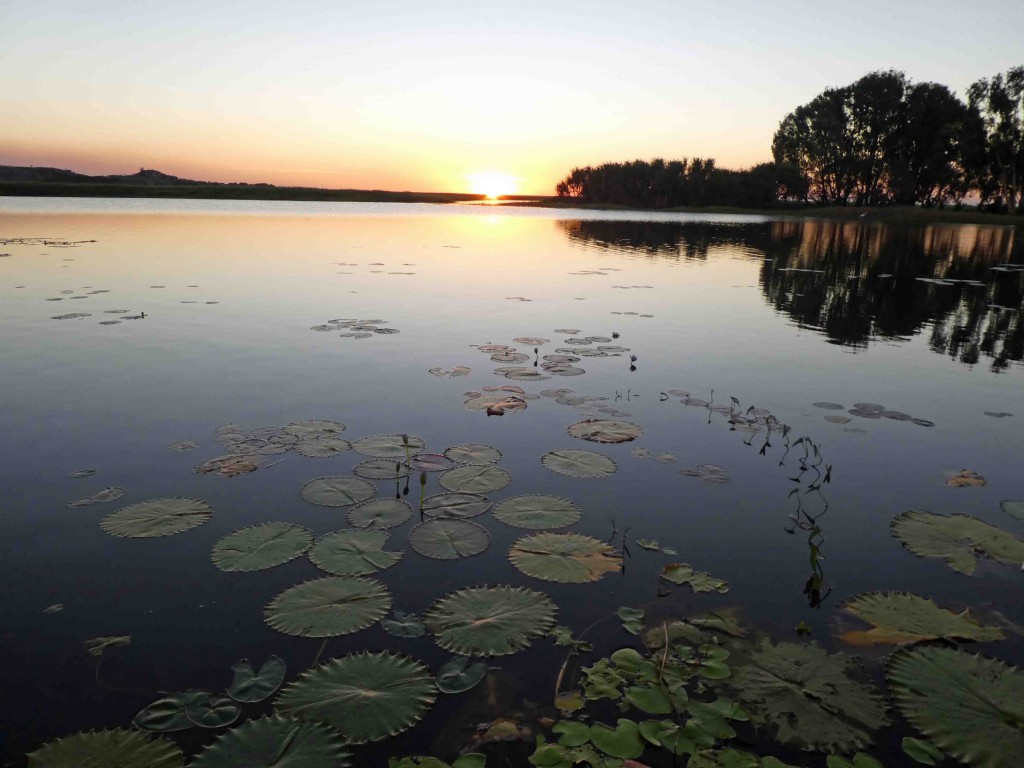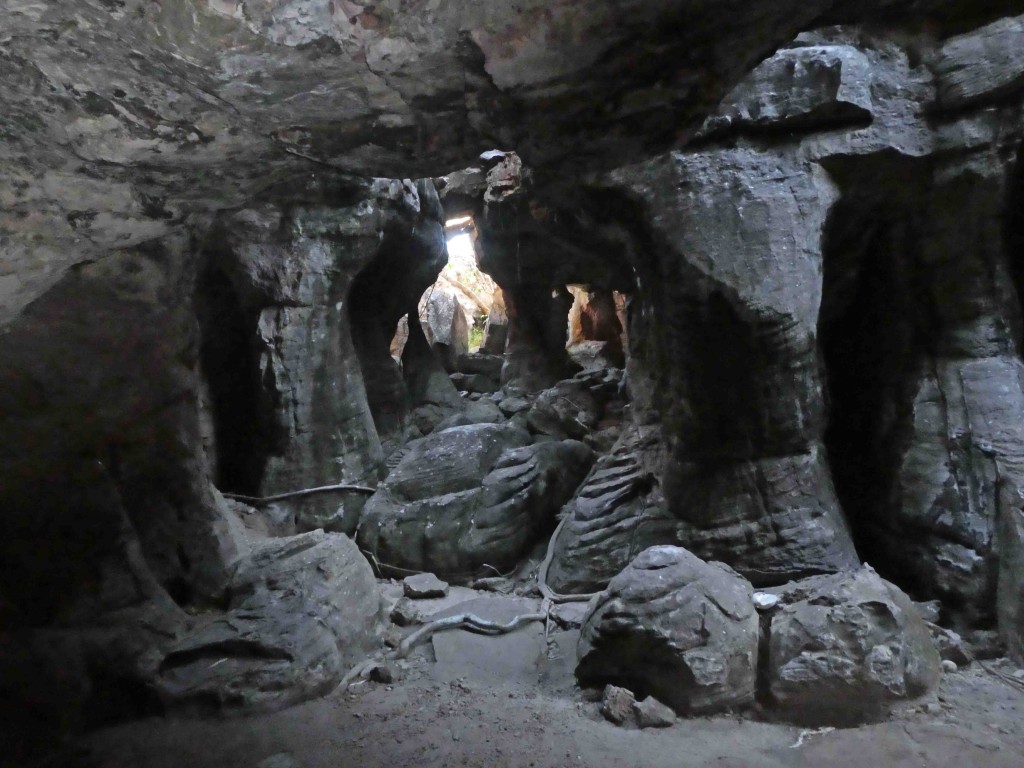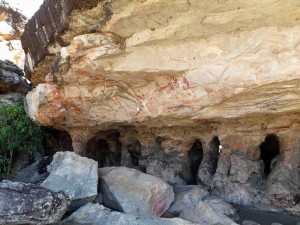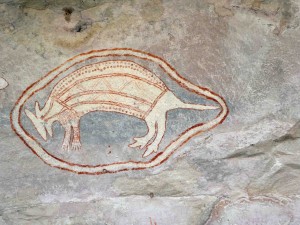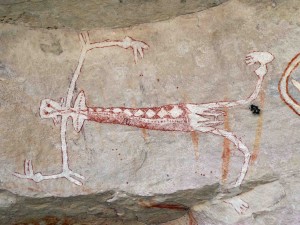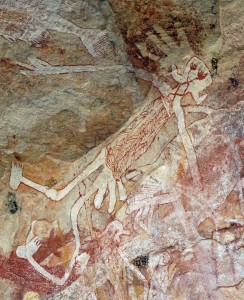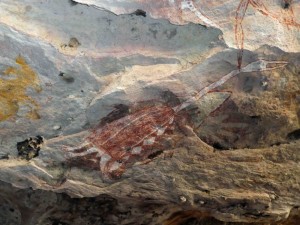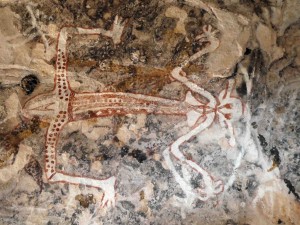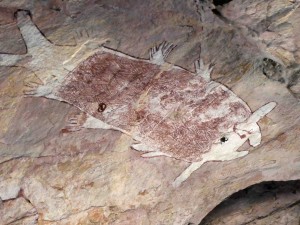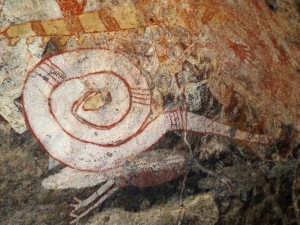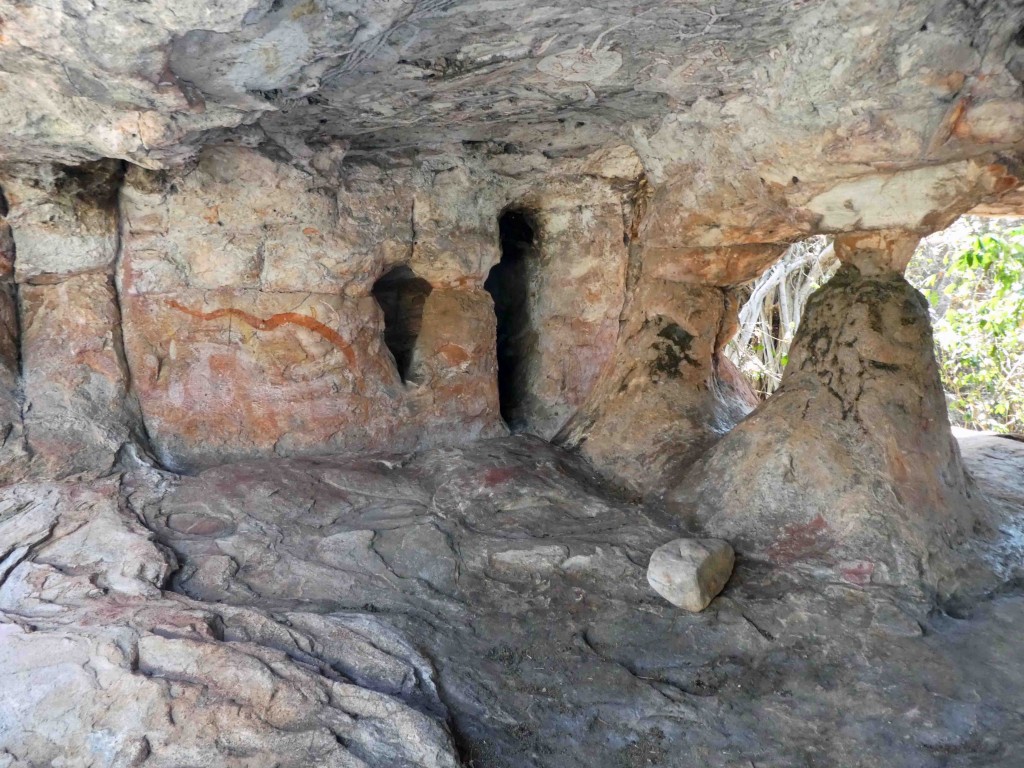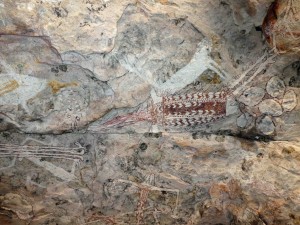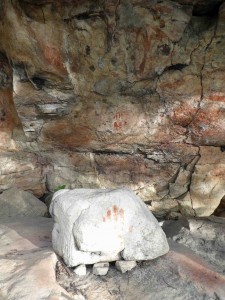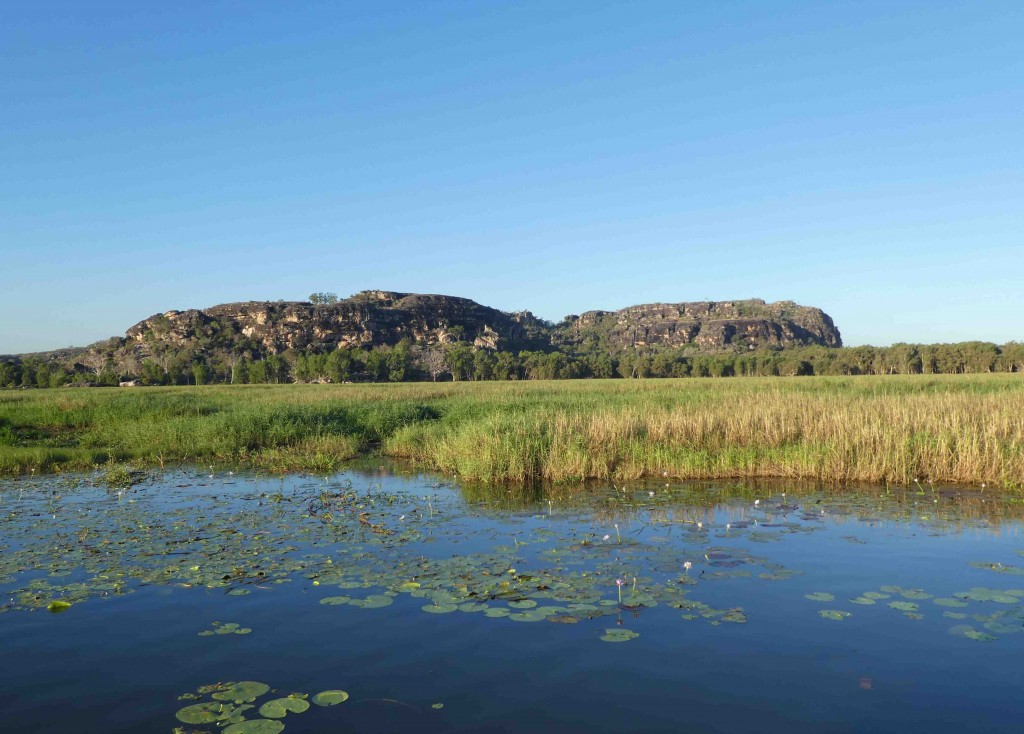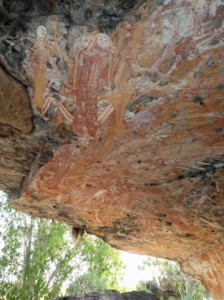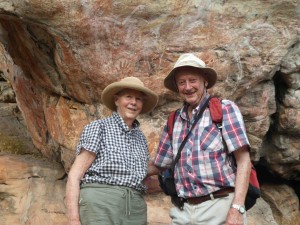THE STUNNING CAVE PAINTING OF THE RAINBOW SERPENT AT MT BORRADAILE
This stunning image of the Rainbow Serpent painted under a rock overhang near Mr Borradaile in Arnhem Land is thought to be the largest ever discovered in northern Australia. For me it was the precursor to three days of joyous discoveries with Davidsons Arnhemland Safaris in July 2018.
During the dry season it is possible to drive in to the resort complex, but my wife Ros and I chose the option of flying in from Darwin Airport in a light aircraft, that not only brings in clients, but all the food and freight to support visitors who do not self-drive.There are some unique aspects that combine to make this particular dry season experience special. Due to the long-time partnership of former buffalo shooter Max Davidson, his wife Philippa and the senior traditional owner of the wider Mt Borradaile area, Charlie Mangulda, visitors access has been strictly controlled since the first base camp was opened in 1986. This means, for example, that artefacts found in the many decorated rock shelters in the ancient sandstone outcrops have been left in place where Aboriginal people once lived in an unbroken occupation now dated as as far back as 55,000 years.
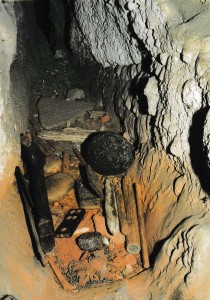
In ‘Artefact Cave’ these relics dating from the 19th century and beyond can still be seen by visitors.
Images courtesy of Davidson Arnhemland Tours
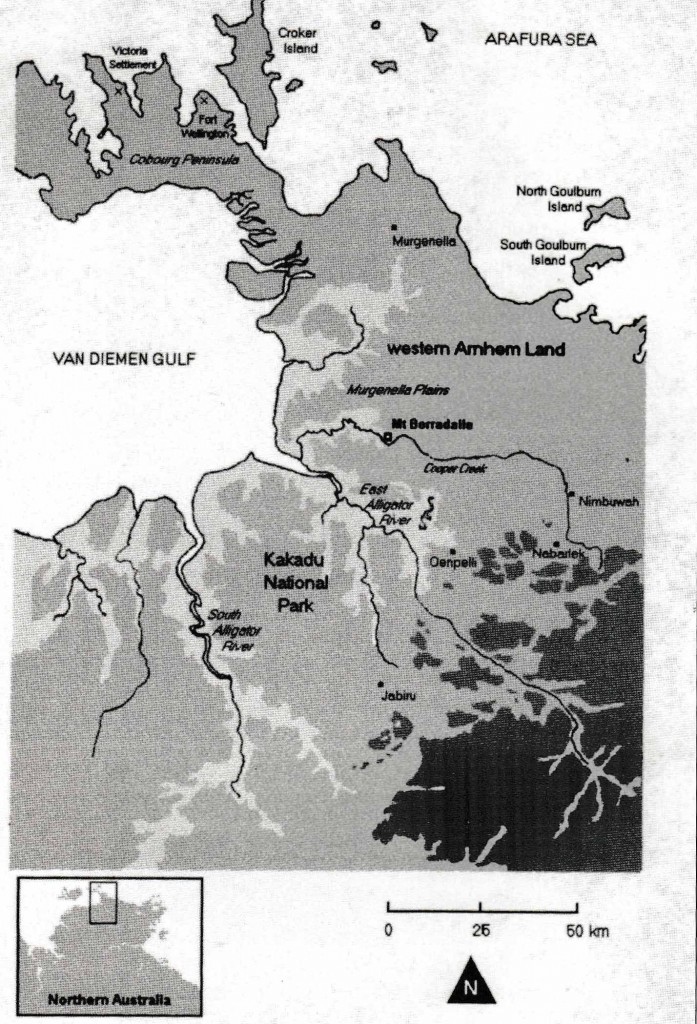
The location of the traditional area has been deliberately kept vague for sensible reasons. But this map does show the general region of Arnhem Land with an insert underneath showing the extent of the land available to the Mt Borradaile venture.
Image Courtesy Davidson Arnhem land Safaris
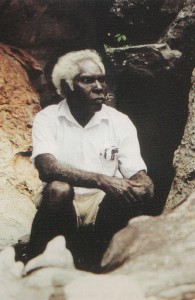
Senior traditional owner of Mt Borradaile, Charlie Mangulda.
Image courtesy of Davidson Arnhemland Safaris
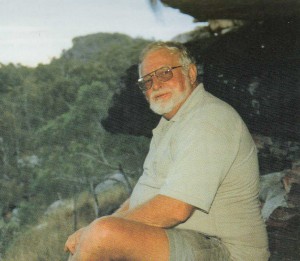
Max Davidspm, a former buffalo shooter, who joined in a partnership with Charlie Manguda. Max died in 2017 and his daughters Diana and Lee are the current owners of Davidson Arnhemland Safaris.
Image courtesy of Davidson Arnhemland Safaris
DAY ONE
After touching down on the gravel airstrip, we were whisked away an open sided Toyota troopie to the resort, taken to our cabin (no windows, just surrounds of mosquito-proof netting) with no lock on the door – why bother in such user-friendly surrounds – offered a cuppa and driven away for our morning tour with our well-informed and genial guide Scott Adams to make our acquaintance with the superb rainbow serpent and other brilliant rock art that seemed to adorn every rock overhang (well almost) with the best sheltered spots featuring a rather crowded canvas, where newer images had been painted over older ones.
We had come from the chill of winter in New South Wales to pleasant daytime dry season temperatures of 32 degrees C. Back for an air-conditioned lunch at noon, we were introduced to the very civilised routine of retreating to our cabin, and having a siesta under slowly turning ceiling fans before our afternoon foray began at 3.30 pm.
This time we took to the water in an aluminium punt with a gently purring outboard to cruise the channels (parts of which were due to become isolated billabongs as the waterways were drying up as the dry season progressed. But the plains were still lush and green, and waterbirds large and small flew languidly away as we passed by. The smallest, I was amused to hear from Scott was known as the Jesus bird – because it seemed to walk on water! In fact its small birdy body could be safely supported by water lilies, on which it hopped cheekily about. I managed to get a photo, which was a bit of luck for a ‘point and snap’ photographer like me.
Without warning, Scott gunned the outboard and suddenly shot up what looked like an extremely small creek. He needed the extra speed to stop the propeller being fouled by weed, and we seemed to be heading cross-country with the reeds on either side looming over us. Clearly he had done this before, and after some nifty navigation we came out into open water and moored the boat beside some rocks. We were sharing the afternoon with another couple, Fergual and Mary, who originally hailed from Ireland but now live in the UK. Fergual was a REAL (he said amateur) photographer with one camera sporting a long lens of gargantuan proportions, and a smaller camera hung from his wrist for good measure. As we had a fairly long walk, and some rock scrambling to get up the escarpment, Ros and Mary elected to wait in the punt.
We had not gone far before we saw (or Scott did because he knew it was there) some signs of previous occupation in the form of round grinding holes on a flat rock.
We were on our way to a cave that had only been discovered in 2002 (well re-discovered I guess as its original inhabitants knew where it was) by Max Davidson and his companion, geologist James Robertson.
They climbed up, looking for obvious caves and rock art sites, and at one stage one went left and one went right. There wasn’t much to see on the right, but the cave on the left – now rather prosaically known as Left Hand Cave – was a ripper. As though a harbinger of goodies to come, this small panel of paintings marked the entrance.
This had obviously been an occupied shelter, and we saw evidence of a burial site, with a human skull on the ground, that had probably been dislodged from a rock crevice by a dingo. Scott asked we not photograph this, as custodian Charlie Mangulda had cleared the cave for people to visit because he considered the burial site not particularly important or significant. We quickly discovered a rich variety of rock art nearby, some of which was relatively recent, as the depiction of a sailing ship, painted over obviously older images, made clear. This was the first of many such images of early European contact we would see at later sites.
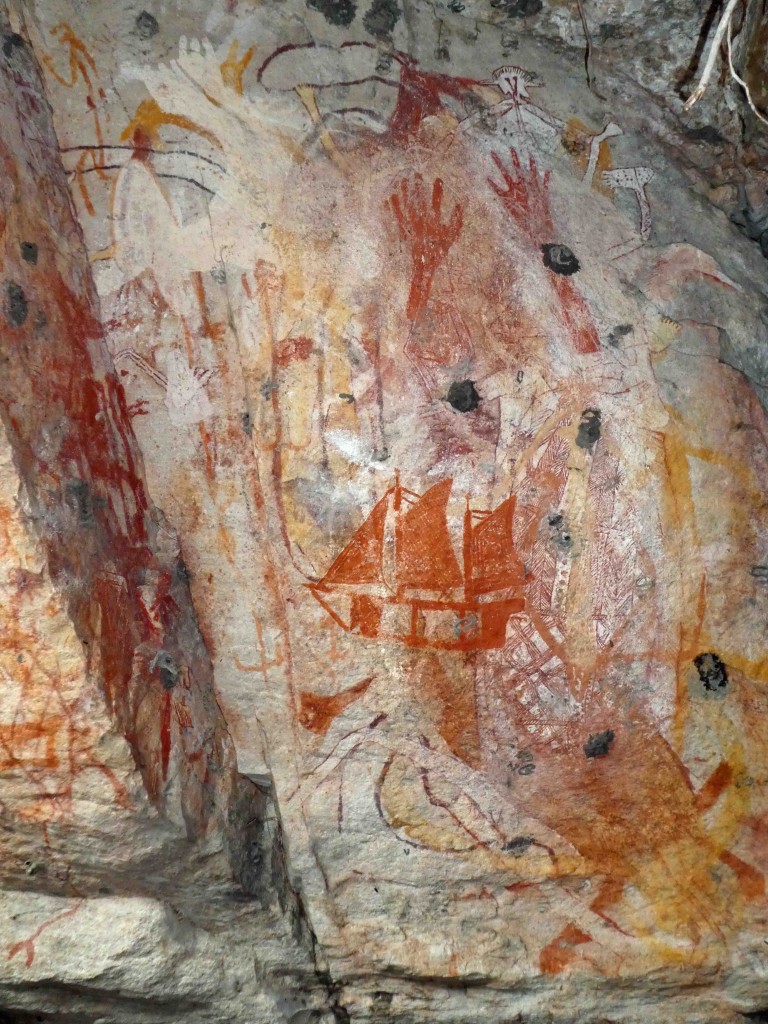
Perhaps a gaff-rigged pearling lugger? The hollow spaces in the hull remained unexplained – maybe signifying cargo holds?
The use of hand prints goes back many thousands of years. However in other art sites in northern Australia from the Kimberley across to the Northern Territory I have never (as I remember it) seen forearms included, which is a common feature of Mt Borradaile indigenous art
DAY TWO
Our morning excursion was to an area known as the Thylacine art site. The Tasmanian Tiger, wiped out by the early 1930s by a bounty put on their heads for killing sheep – later revealed as spurious – but had been extinct on mainland Australia much longer.
(Black and white footage of the last thylacine in the Hobart Zoo can be seen on youtube.
https://www.youtube.com/watch?v=6vqCCI1ZF7o
The story goes that the photographer kept kicking and prodding the unfortunate mammal to keep it moving, until the irritated animal actually bit his tormentor on the bum!)
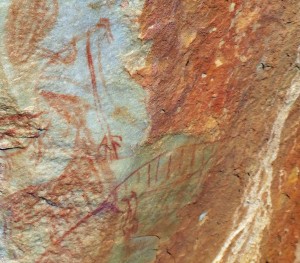
Unfortunately the rock face with the painting was difficult to photograph in full sun, but clearly depicts a marsupial wolf with stripes on its back and a long tail.
Thylacine images do show up in indigenous art, and I recall seeing depictions of Thylacines in the Kimberley some years ago.
Our guide Scott was constantly keeping us up to date with bush medicine botany. He had us taste a small, hard fruit, apparently bursting with ginormous quantities of Vitamin C. It was also very bitter, and despite a warning to be careful I fanged it a bit too enthusiastically and could not get rid of the acrid taste until Scott produced a welcome orange with morning tea.
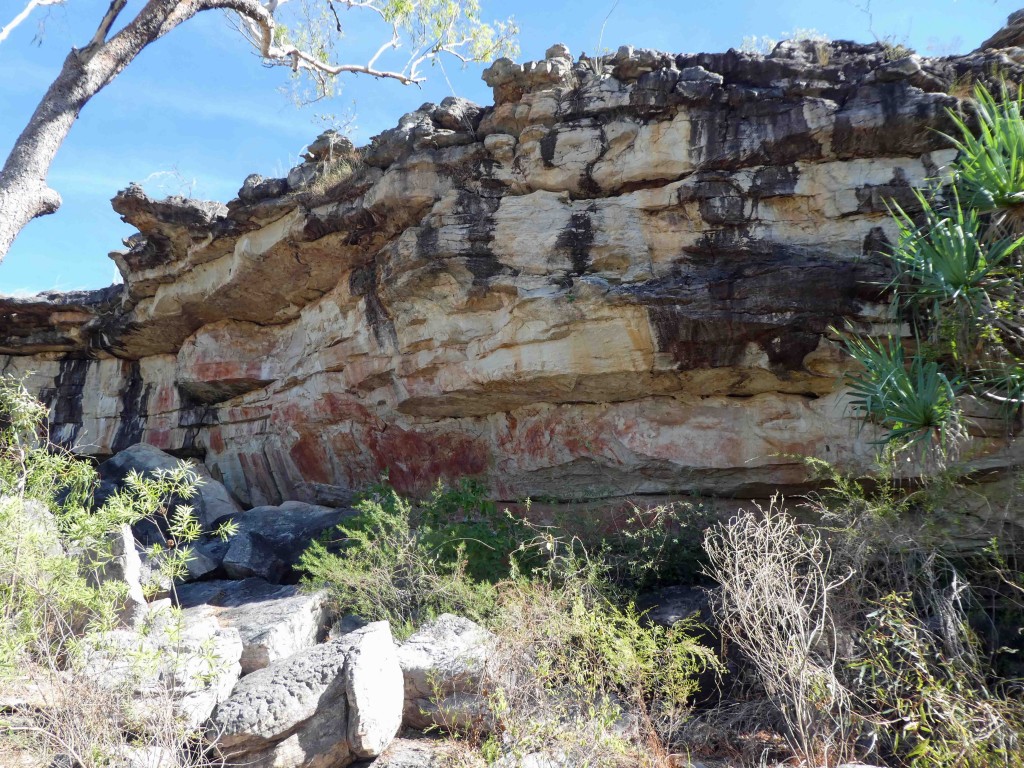
The area near the Thylacine art is particularly rich in art galleries and this is one of many galleries easily seen from afar.
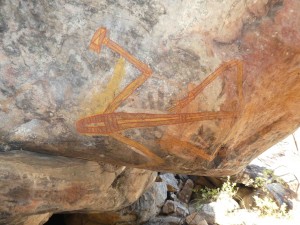
Possibly a spirit figure but definitely female as the exaggerated genitalia to the left of the painting makes clear.
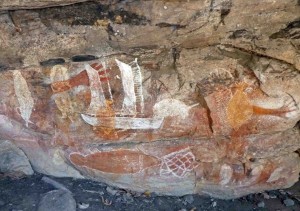
A nice juxtaposition of a pearling lugger and a fish entering a trap beneath. The ladder like additions in front of the sails may be the artist’s depiction of ratlines.
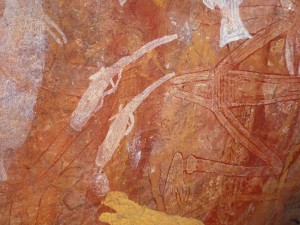
Certainly a post-contact depiction of a brace of pistols, thought to be Cooper side-arms issued to frontier police in the 1850s.
Ros had scratched her leg on a sandstone rock, and Scott stemmed the bleeding with a clever use of a local leaf used by local people, who peeled back the leaf exposing a thin membrane, which he placed over Ros’ abrasion, a piece of the original leaf at each end like a Band-Aid, which stemmed the bleeding and disappeared as the wound healed over in the next 36 hours. Still kicking myself I failed to take a photograph! The leaf came from a Swamp Bloodwood, (Corymbia ptychocarpa).
After lunch and welcome siesta, we headed out in the late afternoon on the water again where lazy saltwater crocodiles sunbathed on the billabong banks, their mouths slightly agape to cool down their saurian brains in the afternoon heat. They were completely oblivious to our boat getting to with a few metres of them. At the top of the food chain, what did they have to worry about?
This was a Sunset Cruise, complete with canapes and cold sauvignon blanc provided by the management.
DAY THREE
It came as a shock to realise this was our last day. I had asked to visit one of the more remote areas at Mr Borradaile, rather ominously known as The Catacombs. With a certain amount of rock-scrambling part of this three-hour walk, Ros decided to spend the morning at the resort. Scott Adams had to fly out to Darwin that day, and Tina Jensen was my guide. I was the only guest, but Diana Davidson, one of the owners of Davidson Arnhem Land Safaris had decided accompany us.
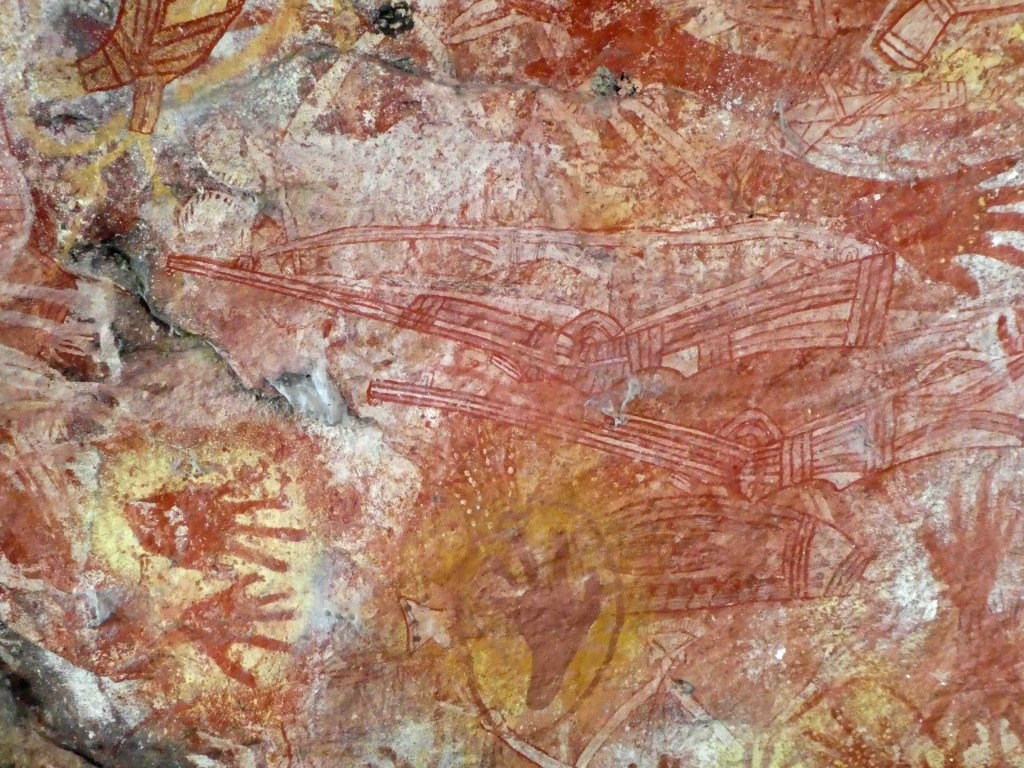
Of course the interaction between Europeans and the First Australians in the 19th century was not always peaceful, and Aborigines were shot and killed, sometimes by buffalo hunters. It is not surprising that these detailed and accurate images of Martini Henry rifles appear among the hand prints and other images on this gallery wall.
OUR LAST AFTERNOON
Ros joined us for the last afternoon excursion – a boat trip to the lower slopes of Mr Borradaile itself, a location where we were only permitted to see a certain number of cave art sites. I was not sure whether Ros could manage the last part of the walk, and Diana Davidson kindly decided to come with us to help her. Tina Jensen told me later that she was uneasy about leaving Ros alone, as wild pigs or even a lone buffalo could appear! In any event, she managed the entire walk with Tina and Diana’s assistance and we saw no buffalos and only a few wild black pigs in the distance. They are so rank and disease-ridden that they cannot be eaten even if they are shot.
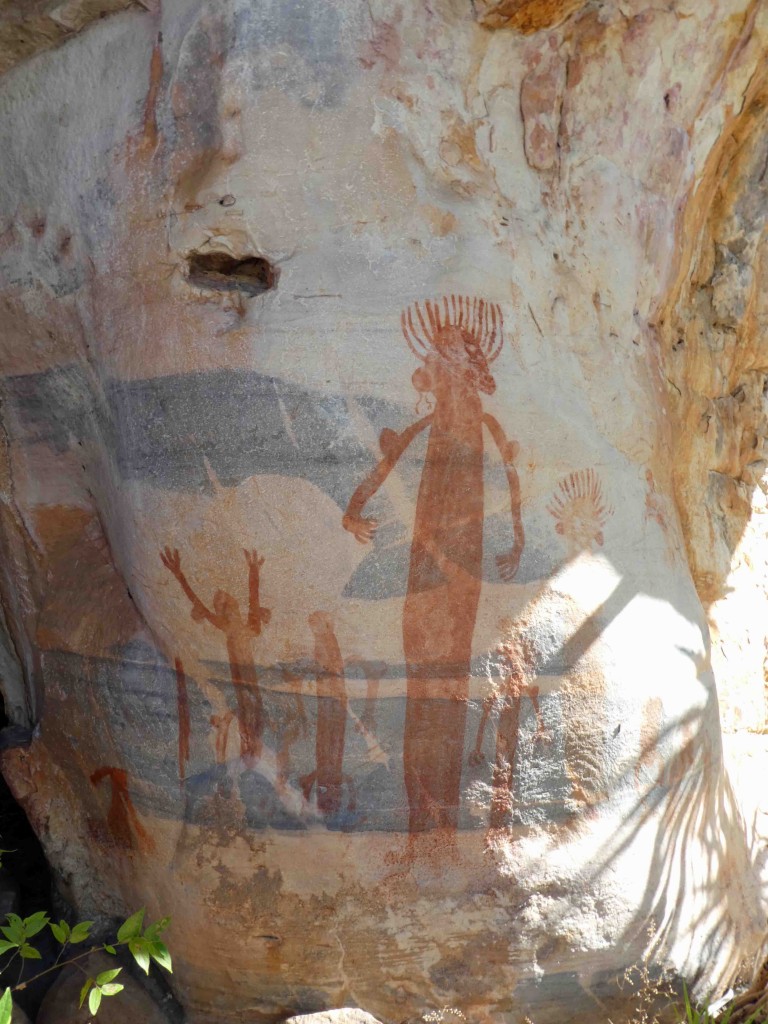
These mysterious figures cannot be categorised and are unlike any other images in the Mt Borradaile area. The sex cannot be determined, and perhaps they are wearing sarongs? The central tallest figure seems rather intimidating, perhaps confirmed by the rather despairing raised arms of the smaller person in the background.
The senior traditional owner of the Mt Borradaile area, Charlie Mangulda, was persuaded by a documentary film crew to be shown putting his hand-print in a cave under the mountain. Unused to the ways of film crews, Charlie, ground up the ochre he needed with water, placed his hand in the slurry, and put his hand-print on the wall. Horrors! The film crew were not ready when he did this, and it had not been filmed.
Charlie refused point-blank to do it again, as it would have been against tradition to do so. The distraught crew sought a compromise. So a white rock was placed in front of Charlie’s already placed hand-print (seen above the white rock on the rear gallery) and Charlie did it again. He regarded this as a ‘rubbish’ exercise, only possible because the rock was not part of the cave. The film crew got their shot, and the white rock can still be seen where it was positioned!
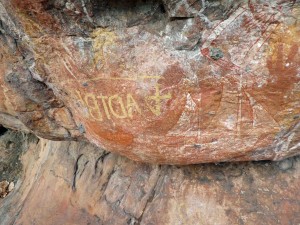
Note this delightful action painting of a pearl lugger, with perhaps an attempt to paint the word BOAT, but with misplaced letters
Our last cave of the day – and our Mt Borradaile adventures – turned out to be the most interesting of our final day.
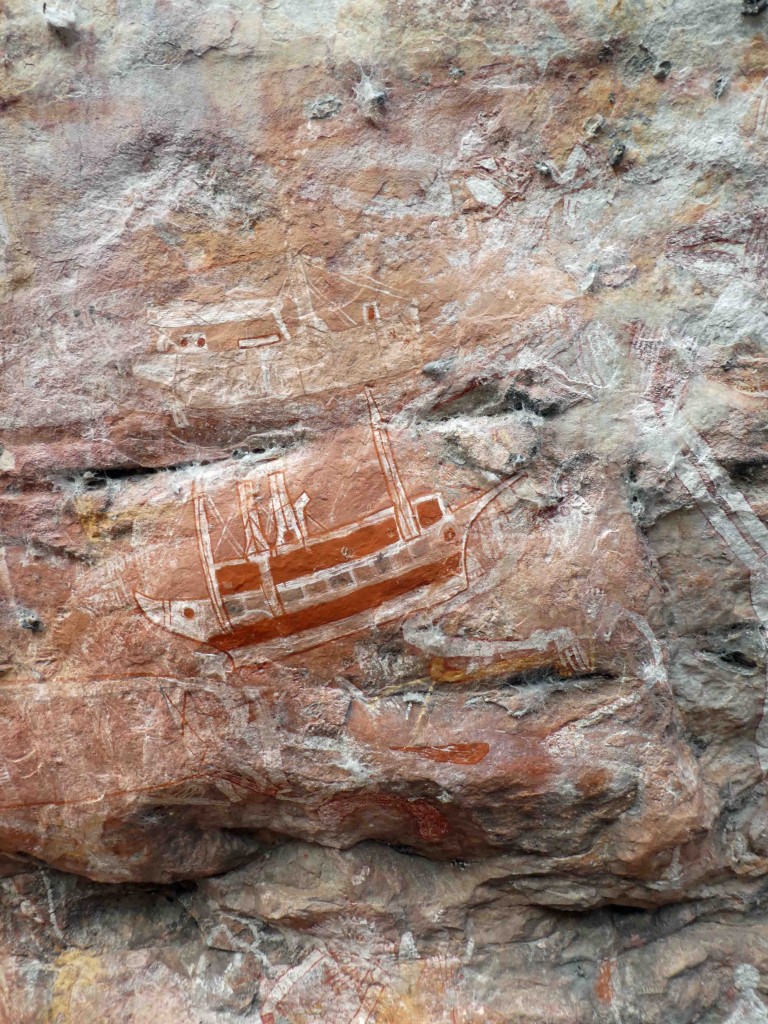
Not one, but TWO steam-assisted sailing ships are depicted in this art site under Mt Borradaile. It is believed the artist may have been familiar with both Macassan and European craft. Perhaps the lower vessel may be a substantial British warship from the 19th century. The line of squares along the middle may be gun ports. Some British warships of the early steam era did have both masts and funnels.
It was hard to believe our three days in this very special part of Arnhem Land were all but over.
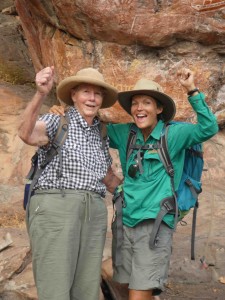
Tina and Diana (Tina pictured right) did well to coax Ros all the way to this splendid last rock art overhang.
I have to admit that Mr Borradaile was on my bucket list. Now that I have clocked up 81 years since arriving home, it must also be noted that there is nothing else on the list! For the moment anyway…
********

